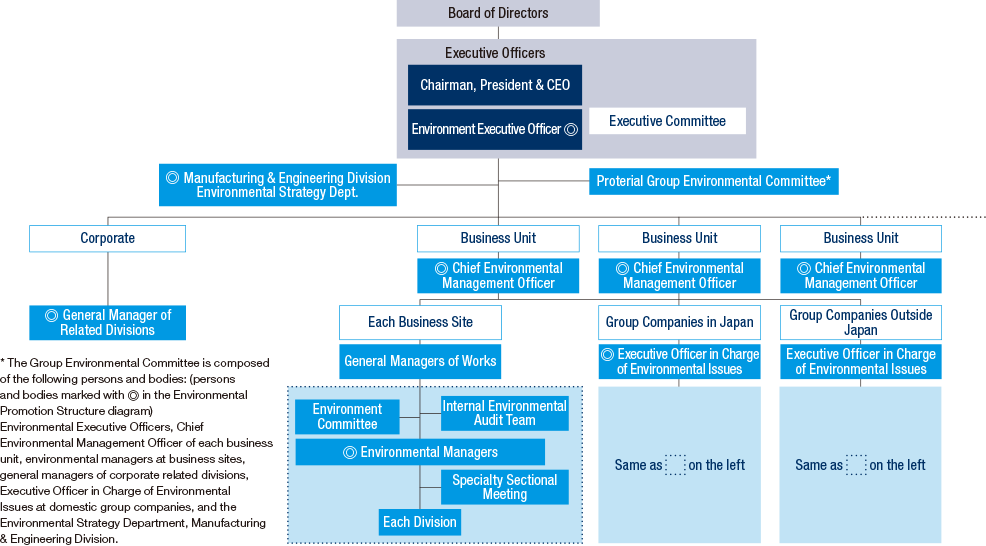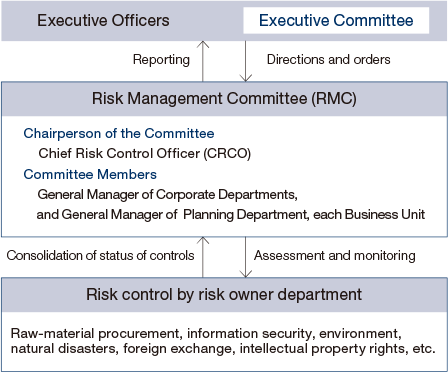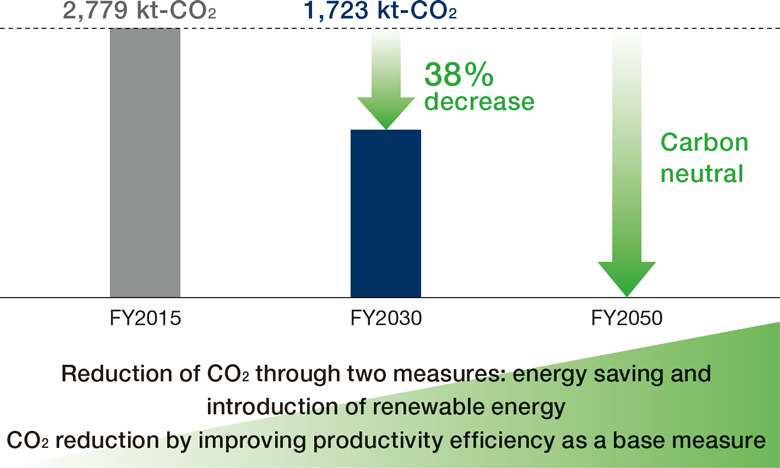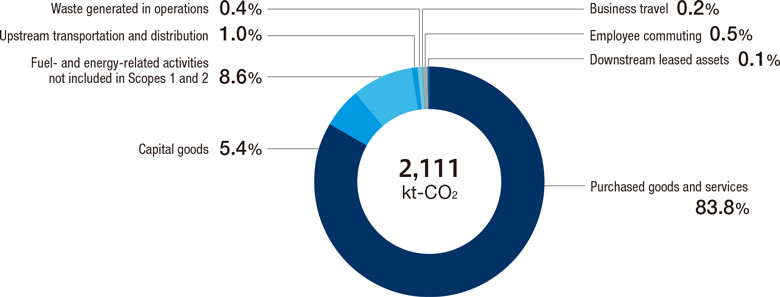Disclosure Based on TCFD Recommendations
Disclosure Based on TCFD Recommendations (October 10, 2023)
1. Response to TCFD Recommendations
As countries around the world intensify their efforts to address climate change in accordance with the Paris Agreement, the Japanese government announced in October 2020 its policy goal of reducing emissions of greenhouse gases, as typified by carbon dioxide (CO2), to virtually zero by 2050. Accordingly, companies are expected to be more proactive than ever in their efforts to transition to a decarbonized society.
The Group considers the impact of climate change on its business as one of our most-important management issues, and we believe that enhanced disclosure of climate-change-related information is a key factor in building a relationship of trust with our stakeholders. Accordingly, in June 2021, we registered our support for the TCFD* Recommendations, and in accordance with the TCFD Recommendations, the Group will continue to enhance our disclosure of information on the impact of climate change on our business activities.

- *The Task Force on Climate-related Financial Disclosures (TCFD) was established by the Financial Stability Board (FSB) in 2015 in response to requests from the G20 for climate-related disclosures. The TCFD published its final report in June 2017, in which it recommends companies to disclose items related to climate change-related risks and opportunities.
2. Governance
In April 2010, the Proterial Group established the Group Basic Policy on Environmental Preservation to clarify the Group’s unified approach to environmental management. In June 2021, we registered our support for the TCFD Recommendations, and in August of that year, following a report to the Board of Directors, we established a new environmental policy named “Aiming for Green Growth while taking Risk as Opportunity.”
The Proterial Group Environmental Committee (Group Environmental Committee, hereafter) has been established as a framework for promoting environmental activities such as climate-change countermeasures. The Group Environmental Committee is chaired by the Environment Executive Officer, and its executive office is the Environmental Strategy Department, Manufacturing & Engineering Division. Its activities are promoted in cooperation with the environmental managers of each business unit, business sites, and group companies. The Group Environmental Committee is responsible for developing environment-related regulations, setting targets for reducing environmental impact, and confirming that activities are appropriate and effective.
Policies and targets concerning environmental activities are discussed and set by the Group Environmental Committee as annual environmental-action plans. With regard to climate-change countermeasures, the Environmental Action Plan sets targets for reducing CO2 emissions within the Group. On the basis of those targets, energy-saving activities and the use of renewable energy are being promoted at each manufacturing site. The status of reductions in CO2 emissions is monitored regularly, and the Group Environmental Committee meets once a year to share the results of the previous fiscal year, the status of numerical targets for the current fiscal year, and major initiatives to promote continuous improvement of activities. Since fiscal year 2021, the Executive Officer in charge of the environmental issues (Environment Executive Officer after January 2023), who chairs the Group Environmental Committee, reports to the Executive Committee and the Board of Directors twice a year on the status of efforts, including climate-change measures, to address environmental issues.
■ Status of important decisions on climate change in fiscal year 2022
| Month/Year | Decisions on important issues related to climate change | Meeting body |
|---|---|---|
| March, April 2022 | Environmental strategy and status of initiatives | Executive Committee, Board of Directors |
| May 2022 | TCFD information disclosure | Executive Committee |
| September 2022 | Support GX League | (President’s decision) |
| October, November 2022 | Environmental strategy and status of initiatives | Executive Committee, Board of Directors |
| April 2023 | Transition from supporter to member in the GX League | (President’s decision) |
■ Environmental Promotion Structure

- Executive Officer in Charge
The executive officer in charge of manufacturing and technology is in charge as an Environmental Officer and exercises overall control through the Group Environmental Committee. - Proterial Group Environmental Committee
Deliberate and determine policies, targets, etc. related to environmental activities within the Group. - Chief Environmental Management Officer
Oversee environmental-management activities within the business units. - Environment Committee
Deliberate and determine policies, targets, etc. related to environmental activities at each business site. - Environmental managers
Take responsibility for and promote environmental-management activities at each business site.
3. Strategy (Scenario analysis)
The Group has begun “scenario analysis” to clarify the risks and opportunities posed by future climate change and to develop business strategies to reduce risks and expand opportunities. While we recognize that scenario analysis should cover the entire group, including the supply chain, in fiscal year 2021, we limited our analysis to a limited number of scenarios and scope of coverage. In fiscal year 2022, we completed the analysis of our domestic business.
In fiscal year 2023, we reevaluated our domestic business for each business unit in line with the transition to the new system. From now onwards, we will promote scenario analysis that includes overseas operations.
Scenario-analysis Process
Scenario analysis—consisting of the four steps shown in Figure 1—aims to assess (i) financial and business impacts under different scenarios and (ii) resilience of the Group strategy in regard to climate-related risks and opportunities.
■ Assumptions for scenario analysis
- Scenarios
- Refer to the “below-2°C scenario” for risks and opportunities excluding physical risks and the “4°C scenario” for physical risks.
- Target businesses
- FY2021:
Advanced Metals Division (Domestic sites)
FY2022:
Advanced Components & Materials Division (Domestic sites)
FY2023:
Each division (Domestic sites)
- Target Fiscal Year
- Impact as of 2030
■ Reference scenario
| Classification | Main reference scenario |
|---|---|
| Below 2°C scenario | • IEA World Energy Outlook 2020. Sustainable Development Scenario • IPCC RCP2.6 |
| 4°C scenario | • IEA World Energy Outlook 2020. Stated Policy Scenario • IPCC RCP8.5 |
■ Scenario-analysis Steps (Figure 1)

The following table shows the results of our review of the risks and opportunities posed by climate change.
| Classification | Type | Content | Business/financial impact | Our response | ||||
|---|---|---|---|---|---|---|---|---|
| Specialty Steel |
Roll | Pipe* | Automotive castings |
|||||
| Risk | Transition | Policy/ regulations |
Increased production and operating costs owing to stricter regulations on carbon pricing (CP), which includes carbon taxes, taxes on fuel and energy consumption, and emissions trading. | Medium | Medium | Small | Medium | Currently, we are working towards improving energy consumption per unit of production by 1% or more per year by promoting various energy-saving measures (LED lighting/replacement and introduction of high-efficiency equipment) and productivity improvement measures. Aiming to become carbon neutral by 2050, we plan to actively promote fuel conversion and introduction of renewable-energy facilities (installation of solar panels) as additional measures to achieve the 2030 CO2-reduction target. |
| Higher procurement costs of raw materials (including rare metals and auxiliary materials such as direct complementary materials) due to stricter regulations concerning CP. | Medium | Small | Small | Medium | As for principle raw materials, we will strengthen surcharges (price sliding-scale system) and cultivate new suppliers. From the perspective of LCA, we will increase the utilization ratio of scrap (which generates low CO2 emissions) and nurture new suppliers. |
|||
| Technology | Increased operating costs associated with the introduction of manufacturing processes (based on electrification and alternative fuels) to meet decarbonization requirements. | Medium | Small | Small | Large | When introducing new manufacturing processes, we will examine equipment specifications with the aim of reducing its impact on operating costs. | ||
| Market | Decreased sales of peripheral components of internal combustion engines owing to the expansion of xEVs. | Medium | ー | ー | Large | As for capturing demand for components of automotive internal-combustion engines, we will target the commercial-vehicle and agricultural/construction-equipment fields. | ||
| Decreased sales due to changes in customer procurement standards (RE100 and other compliance requirements) in accordance with decarbonization. | Medium | Small | Large | Small | As for reducing CO2 emissions from manufacturing processes, we will continue to promote both energy conservation and renewable energy, and we will focus on how to respond to customer requests for decarbonization. | |||
| Increased costs of developing new products for a decarbonized society. | Small | Small | Medium | Large | We will develop environmentally friendly products and launch them onto the market sequentially while not being restricted to our conventional business areas. | |||
| Increased procurement risk due to increased demand for raw materials. | Small | Small | Small | Small | We will develop processes that utilize overseas scrap alloys and low-grade raw materials as well as processes. | |||
| Reputation | Decrease in sales due to lower customer evaluations resulting from delays in the development and market launch of environmentally friendly products. | Small | Small | Medium | Large | We will strengthen cooperation between the sales departments and the research and development departments with the aim of developing environmentally friendly products, and we will make strengthening that cooperation a company-wide top priority. | ||
| Physical | Acute and chronic | Orders and sales decreased owing to delays in delivery accompanying the suspension of operations caused by natural disasters due to abnormal weather. | Small | Small | Small | Small | We will systematically improve our production systems in anticipation of extreme weather events. We will expand the BCP system and refine the action manual for emergencies. |
|
| Increased business costs due to rising insurance costs. | Medium | Small | Small | Large | In areas where disasters such as tidal waves and floods are anticipated on the basis of examples of past disaster, we will systematically implement disaster preparedness measures such as relocation of factories and product warehouses, protection of production lines, etc. | |||
| Chance | Resource efficiency | We will increase sales by increasing product value through efficient production and efficient use of materials and energy. | Medium | Small | Small | Small | To achieve the 2030 CO2 reduction target, we plan to promote various energy-saving measures (LED lighting, renewal and introduction of high-efficiency equipment, etc.) and productivity-improvement measures while promoting fuel conversion and introduction of renewable energy (i.e., installation of solar panels). Naturally, we will publicize our efforts and achievements. | |
| Source of energy |
We will increase sales by improving the customer’s evaluation of supplier selection by working on decarbonization. | Medium | Medium | Small | Medium | We will promote CO2 reduction by introducing renewable energy and switching to carbon-neutral fuels. | ||
| Products/ Services |
We will increase sales by developing and launching environment-friendly products onto the market. | Large | Small | Small | Large | We will promote new orders and increase market share of target products by shortening development lead times and reducing costs of environmentally friendly products. We will continue to expand sales of environmentally friendly products, which are expected to be in more demand in the future. Examples: • Mold materials that provide longer service life • Materials for various industrial machinery, undercarriage parts, and exhaust-gas filters that contribute to improved fuel efficiency and reduced emissions by cars • Aerospace products that are expected to improve fuel efficiency of airplanes • Battery materials (clad products) and power-semiconductor materials for use in batteries and other products • Mass-flow controllers that enable semiconductor manufacturing equipment to save energy |
||
| Market | We will increase sales by expanding sales into new global markets with increased demand for environmentally friendly products. | Medium | Small | Small | Small | As decarbonization progresses, products are expected to become smaller, more powerful, and lighter; accordingly, we will develop new applications with various alloys that can take advantage of different material properties. | ||
| We will increase sales by expanding into xEV market. | Medium | ー | ー | Small | Many of our products, including cladding materials, are used in lithium-ion rechargeable batteries, for which demand is increasing with the expanding xEV market, so we expect sales to increase. | |||
| Classification | Type | Content | Business/financial impact | Our response | ||||
|---|---|---|---|---|---|---|---|---|
| Magnetic materials |
Power* electronics |
Electric* wires |
Automotive components |
|||||
| Risk | Transition | Policy/ regulations |
Increased production and operating costs due to tighter regulations on carbon pricing (CP), including carbon taxes, taxes on fuel and energy consumption, and emissions trading) | Large | Medium | Medium | Medium | Currently, we are reducing CO2 emissions by promoting various energy-saving measures (e.g., LED lighting and renewal and introduction of high-efficiency equipment) and measures to improve productivity. From now onwards, aiming to achieve our CO2-emissions target for 2030, we will actively promote fuel conversion and purchase of renewable electricity as well as the introduction of renewable energy (i.e., installation of solar panels) |
| Rising procurement costs of raw materials, including rare metals and auxiliary materials such as direct supplementary materials, due to stricter CP and other regulations. | Large | Medium | ー | Small | As for principle raw materials, we will work to strengthen surcharges (price sliding-scale system) and cultivate new suppliers. From the perspective of life-cycle assessment (LCA), we will increase the utilization ratio of scrap (which generates low CO2 emissions), and in regard to the magnet business, we will work to reduce the amount of heavy rare earths used and reduce procurement costs by developing low-heavy-rare-earth materials and introducing them to the market. |
|||
| Technology | Increase in operating costs due to capital investment involved in the introduction of manufacturing processes (electrification and alternative fuels) to meet decarbonization requirements. | Small | Small | Small | ー | When introducing new manufacturing processes (e.g., introduction of the latest energy-saving technologies), we will examine equipment specifications with the aim of reducing their impact on operating costs. And the increased costs will be passed on to sales prices. | ||
| Market | Decrease in sales due to lower sales prices and lower customer evaluations due to intensifying competition in the Asian market with competing xEV suppliers | ー | Large | Small | Large | We will reduce costs by introducing high-efficiency equipment, improving productivity, and procuring parts locally. | ||
| Sales declined due to the impact on operations caused by the tight procurement of main raw materials resulting from increased demand for copper | ー | ー | Large | ー | We will reduce the amount of copper used by improving productivity and secure multiple procurement routes by securing new suppliers. | |||
| Decrease in sales due to delays in responding to decarbonized-product requirements for existing products or lost opportunities to expand new sales (RE100, etc.) | Small | Large | Small | Large | We will improve the ratio of renewable energy use by promoting introduction of renewable energy and selecting electric-power companies with high RE power-generation ratio. | |||
| Physical | Acute and chronic |
Orders and sales decreased owing to delays in delivery accompanying the suspension of operations caused by natural disasters due to abnormal weather. | Small | Small | Medium | Large | We will systematically improve our production systems in anticipation of extreme weather events. We will expand the BCP system and refine the action manual for emergencies. |
|
| Chance | Resource efficiency |
We will increase sales by increasing product value through efficient production and efficient use of materials and energy. | Small | Small | Medium | Small | To achieve our 2030 CO2-reduction target, we plan to promote various energy-saving measures (switching to LED lighting and renewal and introduction of high-efficiency equipment) and measures to improve productivity as well as actively promote fuel conversion and introduction of renewable energy (installation of solar panels) while publicizing our efforts and achievements. | |
| Source of energy | We will increase sales by improving the customer’s evaluation of supplier selection by working on decarbonization. | Small | Small | Small | Small | Reduce electricity consumption by improving productivity and increase the utilization rate of renewable energy. | ||
| Products/ Services |
We will increase sales by developing and launching environment-friendly products onto the market. | Large | Large | Medium | Medium | We aim to expand sales by developing products that contribute to a low-carbon society. • Various products for xEVs (magnets, SiN, SiC, magnet wires, automotive electrical components, etc.) • Amorphous alloy (MaDC-A) that contributes to higher efficiency of transformers |
||
| Market | The shift to lighter rare earths will accelerate due to increased procurement risks and costs of heavy rare earths due to stricter regulations on CP and decarbonization requirements. | Large | Small | ー | ー | We aim to increase sales by developing low-heavy-rare-earth magnets for customers who are considering replacing rare-earth magnets containing a large amount of heavy rare-earth elements, introducing them into the market, and proposing replacements for rare-earth magnets by improving the characteristics of ferrite magnets. | ||
Definition of assessment of business/financial impact
Large: cost or effect equal to or greater than 5% of sales*1
Medium: cost or effect equal to at least 1% but less than 5% of sales*1
Small: cost or effect is less than 1% of sales*1
ー: Not subject to impact assessment
- *1Net sales of target businesses
As described above, in response to the content of the October 31, 2022 disclosure of the Advanced Metals Division (Domestici sites) and the Advanced Components & Materials Division (Domestici sites), we have reassessed our domestic business by business unit in conjunction with the transition to the new system in fiscal year 2023, and we have verified that our strategy is resilient to each risk and opportunity with respect to the strategy for these businesses.
4. Risk Management
In April 2022, the Group established a “Company-wide Risk Management Committee” (RMC) under the supervision of the Executive Officer responsible for group-risk management. The RMC summarizes various business risks surrounding the Group and contingency plans for those risk, and evaluates their coverage and weighting. Risks related to climate change identified by the Group Environmental Committee, corporate departments, and business divisions are reported to the RMC together with other risks as one of the risks related to environmental regulations. The RMC is scheduled to meet twice a year, and the results of the interim and year-end risk-management assessments of the RMC are reported to and reviewed by the Executive Committee and the Board of Directors.
■ Risk-management structure

5. Indicators and Targets
The Group has set the Scopes 1 and 2 targets for reducing CO2 emissions* as shown in the illustration below. In promoting carbon neutrality, we will continue our conventional energy-saving activities while striving to improve processes such as capital investment, convert to alternative fuels for melting furnaces, heating furnaces, and manufacturing processes, develop technologies based on carbon-free fuel, and introduce renewable energy.
■ Target for reduction of CO2 emissions (whole Group)

- *Scope 1 (direct CO2 emissions by the company)
Absolute amount of Scope 2 (indirect emissions associated with use of electricity, heat, and steam supplied by other companies)
■ Group-wide Scope 1 and 2 results (kt-CO2)
| Target | FY2020 | FY2021 | FY2022 |
|---|---|---|---|
| Scope1 | 777 | 876 | 818 |
| Scope2 | 1,218 | 1,340 | 1,095 |
| Scope1 + Scope2 | 1,995 | 2,216 | 1,913 |
About Scope 3
The Company calculated CO2 amount for Scope 3 Categories 1 to 7 and 13 according to “Basic Guidelines on Accounting for Greenhouse Gas Emissions Throughout the Supply Chain.”
CO2 emissions in fiscal year 2022 totaled 2,304 kt-CO2, of which “Category 1: Purchased Goods and Services” accounted for the largest share (76.2%).
■ Group-wide Scope 3 aggregated results
| Category | Category description | Fiscal year 2021 | Fiscal year 2022 | ||
|---|---|---|---|---|---|
| CO2 emissions (kt-CO2) | Ratio (%) | CO2 emissions (kt-CO2) | Ratio (%) | ||
| 1 | Purchased goods and services | 1,746 | 74.1 | 1,755 | 76.2 |
| 2 | Capital goods | 115 | 4.9 | 106 | 4.6 |
| 3 | Fuel and energy related activities not included in Scopes 1 and 2 | 412 | 17.5 | 391 | 17.0 |
| 4 | Upstream transportation and distribution | 38 | 1.6 | 24 | 1.0 |
| 5 | Waste generated in operations | 27 | 1.1 | 11 | 0.5 |
| 6 | Business trips | 4 | 0.2 | 3 | 0.1 |
| 7 | Employee commuting | 12 | 0.5 | 12 | 0.5 |
| 13 | Downstream leased assets | 2 | 0.1 | 2 | 0.1 |
| Total | 2,356 | 100.0 | 2,304 | 100.0 | |
- *Scope of data: Calculated only for the relevant category in the Proterial Group.
- *Calculation method: Ministry of the Environment DB3.1 and IDEA database Ver. 3.2 were used.
■ Scope 3 Fiscal year 2022 results

Executive compensation
Compensation for our Executive Officers is based upon the achievement of annual targets. From fiscal year 2022, we added the Group’s CO2-emissions reduction target as an evaluation item for climate-change response. We also applied this indicator to management staff, and we are working on carbon-neutrality measures as it’s an important issue facing our business operations.
Internal carbon price
To promote CO2 reduction, we have added the concept of “internal carbon pricing” to our internal regulations related to capital investment. In detail, we set a carbon price (8,000 yen/t CO2) based on the total amount of CO2 emissions after capital investment, and the effect of the CO2 reduction of the capital investment is calculated as profit. (October 2021)
The carbon price will be calculated with reference to the procurement price of renewable energy in Japan and reviewed periodically.